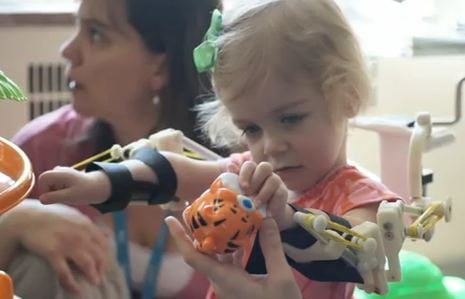3D Printing Enables Toddler To Triumph Over Rare Disease
A couple of months ago, we caught wind of a curious and somewhat dark story about a law student who was attempting to develop schematics for a 3D-printable gun (only to have his 3D printer seized when the leasing company, Stratasys, caught wind of what he was doing). Wherever you fall on that particular issue, it brought to mind some of the potential dangers and pitfalls of the burgeoning 3D printing industry.
This story is the exact opposite of that.
A little girl named Emma was born with a congenital disorder known as arthrogryposis multiplex congenita (AMC) that results in hooked or curved joints and muscle weakness. Emma struggled to move her arms and in fact didn’t have the strength to lift them on her own; when she was born, she could only move her thumb.
Her parents caught wind of the WREX, an exoskeleton that gives AMC patients (particularly children) the ability to use their arms. Emma’s family got in touch with the people behind the project, Dr. Tariq Rahman, head of pediatric engineering and research at Nemours/Alfred I. duPont Hospital for Children, and Whitney Sample, research designer at the same facility, and the team fitted baby Emma with a WREX.

Emma using the WREX
The device worked to an extent--it allowed her to move her arms, play with toys, and bring her hand to her mouth--but it was attached to a stationary pole and was just too big and heavy for her. “The existing WREX was all metal parts, and it’s kind of big, and Emma was too small for that,” said Rahman. They needed a smaller, lighter-weight solution, and one that perhaps wasn’t mounted on a pole.
Such a design was too complex for their CNC machine, so the team turned to a Stratasys 3D printer they had on hand and figured out how to print the necessary parts of the Emma-sized WREX out of strong yet lightweight plastic. It’s actually the same ABS plastic used to make LEGOs. In the process, they also developed a “jacket” and ditched the pole, so Emma could wear the exoskeleton out of the lab and throughout her everyday life. She reportedly loves the WREX, calling it her “magic arms”.

What’s even more amazing is that because of 3D printing technology, replacing any broken pieces (it turns out that little kids are hard on things--who knew?) is very simple. Emma’s parents can shoot a photo of a broken part and email it to the team, who can then print it out and mail it off or have it ready for the family to swing by and pick up.
Rahman and Sample are continuing to refine their designs. 3D printing actually makes that process easier as well, because they can edit their CAD designs and print them the same day.
There’s no better use for technology than to make people’s lives better, and this story is a reminder of the great potential of 3D printing. These guys deserve all the kudos we can send their way.
This story is the exact opposite of that.
Her parents caught wind of the WREX, an exoskeleton that gives AMC patients (particularly children) the ability to use their arms. Emma’s family got in touch with the people behind the project, Dr. Tariq Rahman, head of pediatric engineering and research at Nemours/Alfred I. duPont Hospital for Children, and Whitney Sample, research designer at the same facility, and the team fitted baby Emma with a WREX.
Emma using the WREX
The device worked to an extent--it allowed her to move her arms, play with toys, and bring her hand to her mouth--but it was attached to a stationary pole and was just too big and heavy for her. “The existing WREX was all metal parts, and it’s kind of big, and Emma was too small for that,” said Rahman. They needed a smaller, lighter-weight solution, and one that perhaps wasn’t mounted on a pole.
Such a design was too complex for their CNC machine, so the team turned to a Stratasys 3D printer they had on hand and figured out how to print the necessary parts of the Emma-sized WREX out of strong yet lightweight plastic. It’s actually the same ABS plastic used to make LEGOs. In the process, they also developed a “jacket” and ditched the pole, so Emma could wear the exoskeleton out of the lab and throughout her everyday life. She reportedly loves the WREX, calling it her “magic arms”.
What’s even more amazing is that because of 3D printing technology, replacing any broken pieces (it turns out that little kids are hard on things--who knew?) is very simple. Emma’s parents can shoot a photo of a broken part and email it to the team, who can then print it out and mail it off or have it ready for the family to swing by and pick up.
Rahman and Sample are continuing to refine their designs. 3D printing actually makes that process easier as well, because they can edit their CAD designs and print them the same day.
There’s no better use for technology than to make people’s lives better, and this story is a reminder of the great potential of 3D printing. These guys deserve all the kudos we can send their way.

